Kingston LoVo HyperX: Memory with Low Power Consumption

Kingston introduced unique overclocker dual-channel DDR3 SDRAM kits working at 1.25 V and 1.35 V voltage. We couldn’t help checking out how beneficial memory like that could be in energy-efficient and overclocker platforms.
Despite the continuous aggressive progress in the field of computer technologies, there is no hope that anything principally new will appear in the DRAM market any time soon. As for the upcoming DDR4 SDRAM, it should start entering the market no sooner than in 2012. Moreover, I have to say, that you shouldn’t expect DDR4 SDRAM to be something dramatically different: it will be just another logical step along the long established route: frequencies will increase, capacities will grow bigger, power consumption will go down.
Does it mean that DDR3 SDRAM market has reached a stagnation period in its existence? No, it doesn’t because we see that all the main chip makers work real hard on improving the specifications of the DDR3 products. They introduce new manufacturing techniques, start using new materials. And the results of these innovations are clearly displayed on the store shelves: DDR3-1600 SDRAM has become a mainstream product, while enthusiasts are offered high-speed products like DDR3-2400 SDRAM.
On the other side of this front we also see significant progress. DDR3L SDRAM standard that described DDR3 memory with lower power consumption levels is no longer just a declaration, but a spec of existing products. Solutions like that offering 1.25-1.35 V power consumption instead of the traditional 1.5-1.65 V are primarily interesting for the server community, but nevertheless, they also started appearing in the mainstream market.
Therefore, we decided to take a closer look at this low-voltage DDR3 memory that is why we tested new DIMMs from Kingston that belong to HyperX LoVo series.

Due to lower nominal voltage they consume less power, which should make them a good option for high-performance energy-efficient platforms, according to the manufacturer.
Closer Look at Kingston KHX1866C9D3LK2/4GX (LoVo HyperX)
We took a pair of KHX1866C9D3LK2/4GX for our today’s test session. This is the today’s fastest model in the LoVo HyperX series, designed to work in DDR3-1866 mode. Besides high-speed memory modules like that, LoVo HyperX family also includes DDR3-1800, DDR3-1600 and DDR3-1333. In other words, this is where the manufacturer decided to try and combine two seemingly opposite things: overclocker speeds and energy-efficiency.
LoVo HyperX modules are shipped in a pretty common package: two memory DIMMs with aluminum heat-spreaders sealed in Kingston’s traditional plastic box:
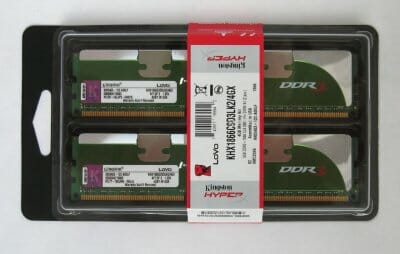
You can easily tell the low-voltage modules from the regular ones by the color of their heat-spreaders: they are green instead of light-blue, which should naturally bring up an eco-friendly associations. Other than that they look just like the regular HyperX memory modules, which we are already well familiar with.
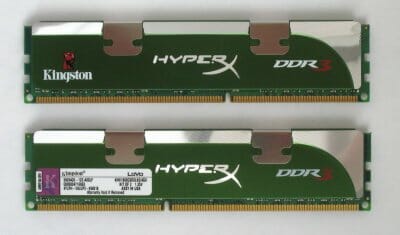
The heat-spreaders are decorated with the company logo, HyperX brand logo and DDR3 sign. “LoVo” name is only mentioned on the sticker together with the full marking. Besides logos, the sticker also bears some technical info, product part number, its operational voltage setting and the fact that it consists of two modules.
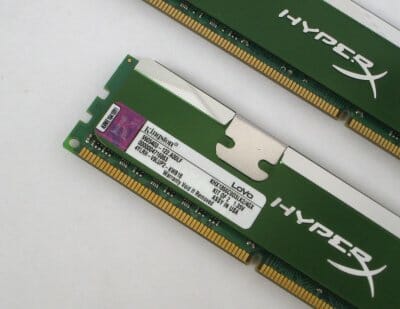
The complete Kingston KHX1866C9D3LK2/4GX technical specification looks as follows:
- Dual-channel kit includes two memory modules, 2 GB each;
- Nominal frequency: 1866 MHz;
- Timings: 9-9-9-27-1T;
- Voltage: 1.35 V.
Besides that, the manufacturer claims that KHX1866C9D3LK2/4GX kit can easily work at 1600 MHz frequency with even lower voltage setting of 1.25 and 9-9-9-27 timings.
These two modes are recorded in the XMP profiles supported by all LoVo memory kits.
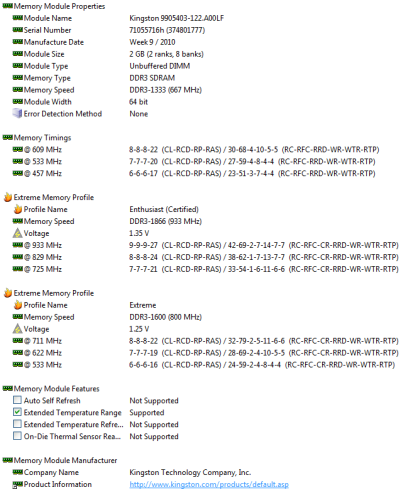
Although LoVo memory boasts pretty exotic specifications, its internal design is quite common. Aluminum heat-spreaders are pressed against the memory chips with two steel locking clips with a traditional thermal band inserted in-between.
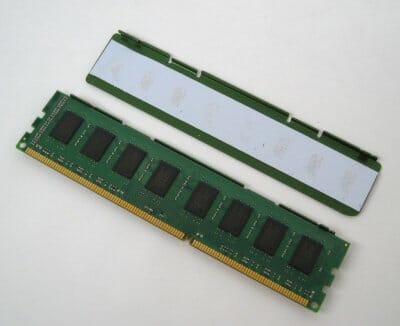
As for the chips, they used the legendary Elpida “Hyper” ones that are currently used in most overclocker products.
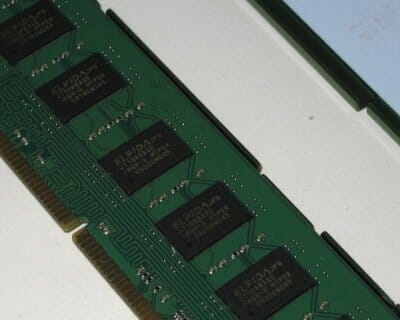
However, in most cases the memory makers would squeeze some record-breaking frequencies out of these chips, while Kingston engineers focused their efforts on a different aspect and picked the chips that could support low voltage settings for their LoVo family of products.
Testbed Configuration
For our tests we put together the following platform:
- CPU: Core i7-860 (Lynnfield, 4 cores/8 threads, 2.8 GHz, 8 MB L3);
- Mainboard: ASUS P7P55D Premium (LGA1156, Intel P55 Express);
- Memory: 2 x 2 GB, DDR3 SDRAM, Kingston KHX1866C9D3LK2/4GX;
- Graphics card: ATI Radeon HD 5870;
- HDD: Western Digital VelociRaptor WD3000HLFS;
- CPU cooler: Thermalright Ultra-120 eXtreme with Enermax Everest fan;
- PSU: Tagan TG880-U33II (880 W);
- OS: Microsoft Windows 7 Ultimate x64;
- Drivers:
- Intel Chipset Driver 9.1.1.1025;
- ATI Catalyst 10.5 Display Driver.
Power Consumption Tests
Since Kingston KHX1866C9D3LK2/4GX memory modules from the LoVo HypperX series we received for review are primarily targeted for energy-efficient systems, we decided to start with the power consumption tests that can show the real effect from using these “green” modules working at lower voltage.
However, before we start talking about the practical power consumption readings, we should say the following. It turned out that far not all desktop mainboards can actually set the DDR3 memory voltage below the standard 1.5 V. Today we are going to use an Asus platform so the minimal voltage on the DIMM slots was 1.2 V, but it seems to be more of an exception than a rule. Many mainboards, such as Gigabyte ones, for instance, can’t set such low voltages. At least not without the special BIOS modifications. So, if you really want to use energy-efficient memory from Kingston’s LoVo series, make sure that your mainboard has corresponding BIOS settings that would allow you to set the memory voltage lower than the nominal.
However, if it does allow you to set lower voltages, then you will immediately see the effect from the LoVo memory even without any measurements. The thing is that these memory modules barely heat during work. Therefore, the heat-spreaders obviously perform purely decorative aesthetic function, but have no practical value.
On the other hand, memory modules make minimal contribution to the power consumption of contemporary systems. Therefore, it would be too optimistic to expect low-voltage DDR3 SDRAM to have any serious influence on the total system power consumption.
You can see from the following graph how things are in reality. It shows total power consumption of our test system without the monitor when we install DDR3-1333 and DDR3-1600 SDRAM on Elpida “Hyper” chips with different voltages: lower 1.2-1.25 V, standard 1.5 V and higher 1.65 V, which is the setting used in all overclocker products. The power consumption was taken “past” the power supply unit and this value represents the total power consumption of all system components combined. In this case we do not take into account the efficiency of the PSU itself.
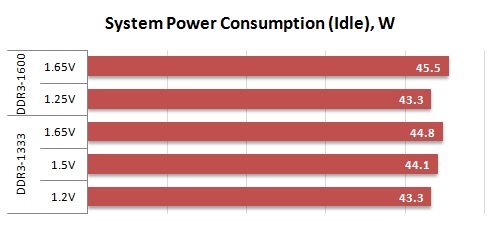
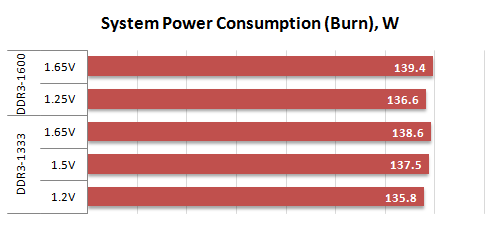
As we have expected, the influence from the memory is minimal. The power consumption difference between the system equipped with low-voltage and regular memory is only 2 W in idle mode and about 3 W under load. And it is no more than 5% of the entire platform power consumption.
In addition to the obtained results, we decided to compare the power consumption of an overclocked system with DDR3-1866 working at 1.35 V and at 1.65 V. These results are given separately, because you need to overclock the processor in order to have the memory work at this frequency. The CPU frequency was increased to 3.4 GHz (22 x 155 MHz). The peculiarity of this overclocking is that it doesn’t require any voltage increase for stable operation of the overclocked system. As a result, the system working in this mode can maintain an optimal ratio between its performance and power consumption.


The results are even less impressive than in the previous case. It is in fact quite logical, considering that you need 1.35 V of power in energy-efficient mode to ensure that the memory runs at 1866 MHz.
However, in defense of the low-voltage memory I have to say that its relative efficiency could have been more noticeable, if we had used energy-efficient and low-voltage component modifications, such as a mainboard with an integrated graphics core and an energy-efficient S-series processor. In other words, LoVo memory will come in very handy in an energy-efficient platform, but in common platforms it will hardly be justified, especially since it is about 10% more expensive than the regular memory modules.
Overclocking Tests
However, it is not only the low operational voltage that makes LoVo HyperX memory modules from Kingston so attractive. Overclockers may also be quite interested in them, because they are based on Elpida “Hyper” chips that boast one of the best frequency potentials out there. And since these are ordinary chips, the memory modules based on them can work just fine at the same voltage as standard and overclocker DDR3 modules do. So, on the one hand, 1.65 V voltage is of no risk to this memory, and on the other, such serious increase in voltage compared with the modules’ nominal setting can be of great value during overclocking.
Well, let’s take a look what Kingston KHX1866C9D3LK2/4GX memory from LoVo HyperX series is capable of during overclocking. Our next series of tests was aimed at finding that maximum clock speed, at which the tested kit could work without any problems using three most typical timings sets: 6-6-6-18-1T, 7-7-7-20-1T and 9-9-9-24-1T. We used different DIMM voltages: from the nominal for this memory 1.25-1.35 V to standard 1.5 V and higher 1.65 V. The stability test during this test session consisted of a 30-minute run of 64-bit Prime95 25.11 version in Blend mode.
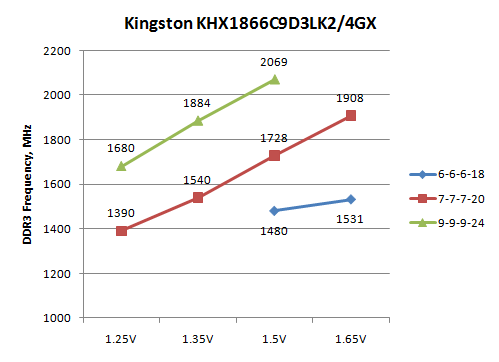
As you see from the obtained results, 7-7-7-20 timings are no problem for Kingston KHX1866C9D3LK2/4GX. Of course, at lower voltages you can only count on frequencies below 1600 MHz, but if you set the voltage at 1.5 and 1.65 V, the results will be very good: the modules will be fully operational at frequencies even higher than 1866 MHz.
The use of less aggressive timings of 9-9-9-24 causes a significant increase in frequency potential, so that you could use Kingston KHX1866C9D3LK2/4GX modules as DDR3-2000 even at 1.5 V voltage.
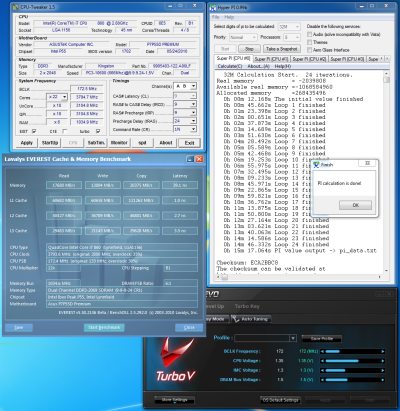
Unfortunately, we couldn’t achieve long-term operational stability during the tests at 1.65 V voltage. The modules equipped with standard aluminum heat-spreaders overheated fairly quickly. That is why there is no result for the 1.65 V voltage setting on our graph. However, with minimal improvement of the modules cooling, Kingston KHX1866C9D3LK2/4GX can definitely produce a more impressive result.
Instead, the kit proved fully operational with aggressive 6-6-6-18 timings. We had to sacrifice some frequency in this case, but nevertheless, the ability of this memory kit to work as almost DDR3-1600 with timings like that may come in very handy in certain conditions.
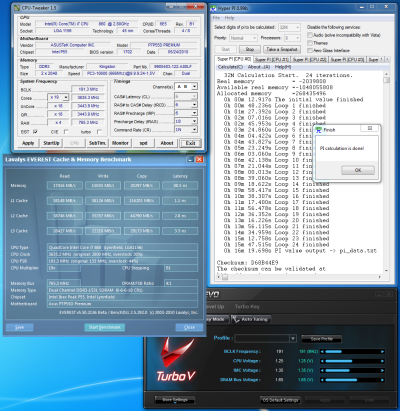
Summing up the obtained results, I have to say that dual-channel Kingston KHX1866C9D3LK2/4GX kit behaves in a pretty typical manner for a memory kit based on Elpida chips. The advantage of these DDR3 SDRAM modules is their ability to conquer pretty high frequencies with 9-9-9-24 timings, which is exactly what we saw during this test session, even though the tested kit is from the LoVo HyperX series.
Conclusion
Formally, Kingston LoVo HyperX is a very specific product. On the one hand, it is positioned as a solution for energy-efficient systems, on the other – as overclocker memory for computer enthusiasts. And this contradiction is very puzzling: the potential user group for this type of memory seems to be very small, if it exists at all. True, there are hardly any overclocking fans, who would be willing to pay extra money for the memory’s ability to work at low voltages, especially since overclocking almost always causes a significant increase in the system energy demands.
The real power consumption tests also aren’t in favor of low-voltage overclocker memory. They showed that lowering the voltage of DDR3 SDRAM modules, which are not very power-hungry to begin with, result in minimal savings of 2-3 watts that will inevitably be lost against the background of overall system power consumption readings.
In other words, we can recommend using Kingston LoVo HyperX memory as directed only in those few systems that are built with high-performance components from energy-efficient and low-voltage product families. And I have to admit that high-frequency LoVo memory discussed today won’t be the best choice for platforms like that. In this case it would be better to go for a slower and cheaper DDR3-1333 SDRAM kit also offered within Kingston LoVo HyperX family.
However, everything is still not that simple. The thing is that Kingston LoVo HyperX modules use regular DDR3 Elpida “Hyper” chips. In other words, the modules ability to work at low voltages is not due to specific components used in them, but simply due to appropriate chips selection. As a result, no one can prevent you from using low-voltage Kingston memory modules at regular voltage of 1.5-1.65 V. and this is where Kingston LoVo HyperX modules start to shine due to the use of very successful components. They turn out highly overclockable. For example, the Kingston KHX1866C9D3LK2/4GX kit we tested today could work stably in modes exceeding DDR3-2000. And in most cases no voltage increase past 1.5 V was necessary.
In other words, Kingston LoVo HyperX is more of an overclocker rather than energy-efficient kit. And if you regard it as such, then purchasing Kingston KHX1866C9D3LK2/4GX will make a lot of practical sense.
We find the idea of low-voltage memory for enthusiasts extremely interesting that is why we are proud to award Kingston KHX1866C9D3LK2/4GX memory our Ultimate Innovation title:
